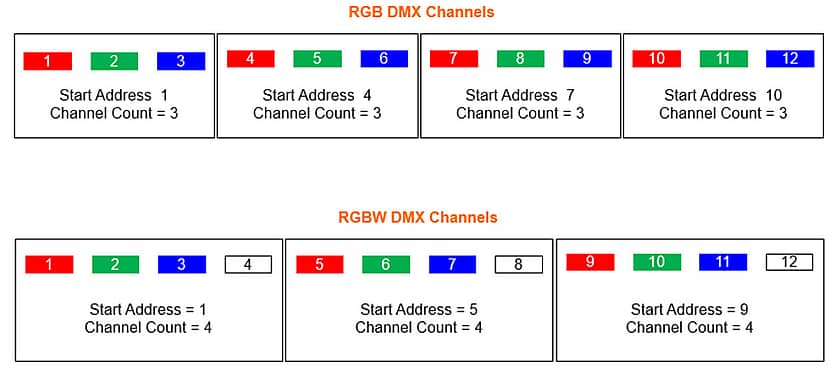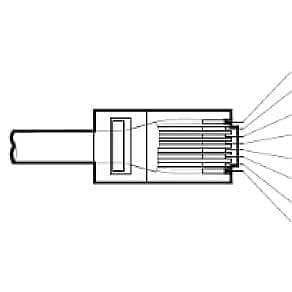What is DMX512?
DMX512 is a lighting control protocol developed by the USITT (United States Institute for Theater (Technology) for the control of theatrical dimmers and ancillary components. Due to its high-speed data transmission, its robustness, and its ease of installation, DMX512 has been coopted for use in the control of architectural luminaires as the need for multi-parameter control has developed.
Is DMX512 a formal standard?
Yes. DMX512 is an ANSI-approved standard. Its formal name is: E1.11 – 2008, USITT DMX512-A. The USITT nomenclature is Entertainment Technology—USITT DMX512-A—Asynchronous* Serial** Digital*** Data Transmission Standard for Controlling Lighting Equipment and Accessories
- *Asynchronous = The transmitter and the receiver are not synced up.
- ** Serial = The data is sent in the order it is received, meaning there is no packet reorganization as is seen with other digital protocols, such as ethernet and TCP/IP.
- *** Digital = The transmitted data is sent as a series of 1s and 0s, and not as a variable voltage or signal.
Why is it called DMX512?
DMX stands for “digital multiplex” and refers to multiple digital control channels being encoded on a single data line. The 512 is the number of digital discrete control channels on what’s called a universe. There is generally one data cable per DMX universe, although further multiplexing is possible using ethernet as a shared pipe to send multiple universes of DMX512 on the same data line.
How is DMX512 transmitted?
DMX512 uses an RS-485 physical layer, meaning within the DMX cable, there are three data conductors – data +, data -, and ground. DMX512 is transmitted over a cable with a single twisted pair with the ground usually landing on a foil shield. There are several appropriate cables that are used for DMX512 transmission. In the architectural world, UTP* Cat5 cable is commonly used, due to its low cost and wide availability. DMX512 cables are traditionally terminated in 5 pin XLR connectors. The DMX512 standard has allowances for different connectors, although the standard implicitly states that three pin XLR connectors are disallowed. Most Traxon and e:cue products use either an RJ45 connector or a hard-wired connection methodology.
- *UTP = unshielded twisted pair

How do different luminaires know what channels to listen to?
Each DMX512 luminaire within your lighting system has a base address. This address allows the luminaire to listen for the correct data from the appropriate channels. The address is between 1 and 512, and the base address is a single digit. Luminaires with multiple parameters use this base address to sequentially add additional parameters and channels. For instance, a single RGBW luminaire with a base address of 1 would have the following channel allocations: Red – 1 / Green -2 / Blue – 3 / White – 4. If this same luminaire had a base address of 5, it would have the following channel allocations: Red – 5 / Green – 6 / Blue – 7 / White – 8. It’s important to note that a luminaires channel allocation varies by manufacturer. For instance, some luminaires may allocate the additive color channels in a different order, such as BGRW, while some luminaires use a different color model altogether, such as HSI instead of RGB.

Does DMX512 transmit and receive data?
No. DMX512 is a unidirectional protocol, meaning it only sends data in one direction, specifically, from the transmitter to the receiver or receivers. There is a protocol that can be added to DMX512 that allows bi-directional communication. This separate protocol is called RDM.
What topology does DMX512 generally use?
DMX512 traditionally uses a daisy-chain topology. This means that a cable would travel from the transmitter to the first luminaire in the universe, where it would land on an input connector. The cable would leave the luminaire from an output connector and run to the next luminaires input connector.
Can DMX be split?
Yes. A DMX512 signal can be split into multiple data runs. However, this must be done via an optically isolated splitter, which is a specialty device. DMX512 cannot be split using wire nuts, traditional splicing, or any other type of cable combination / branching. If an optically isolated splitter is not used, there will be signal reflections which will cause system malfunction.
What’s the deal with DMX termination?
Traditionally, the last DMX512 receiver in a data line must have a “terminator” on its output. A terminator inserts a 120 ohm resistor between the (+) and (-) pins. DMX termination mitigates signal reflections that occur at the end of a DMX line and cause system instability. Some luminaires have a dipswitch to terminate the luminaire while other luminaires have a DMX transceiver that makes termination unnecessary.
Please refer to the USITT website for additional information:


